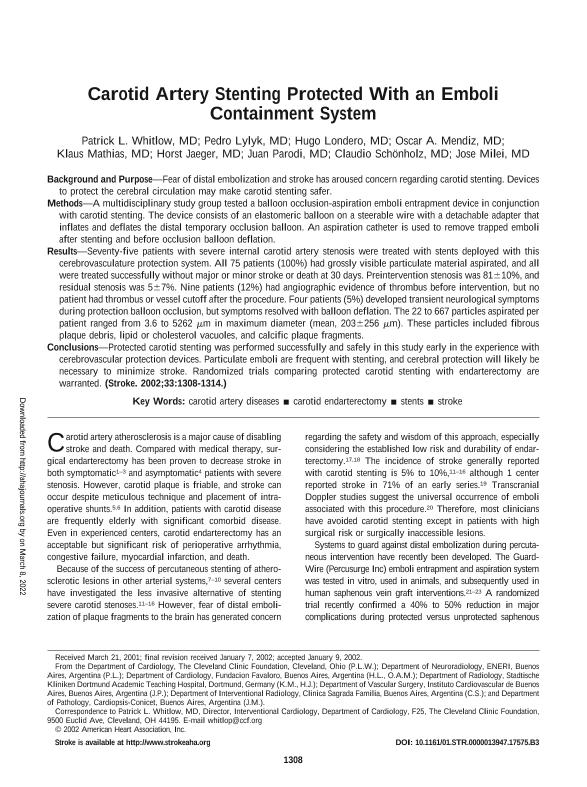Mostrar el registro sencillo del ítem
dc.contributor.author
Whitlow, Patrick L.
dc.contributor.author
Lylyk, Pedro
dc.contributor.author
Londero, Walter Hugo

dc.contributor.author
Mendiz, Oscar A.
dc.contributor.author
Mathias, Klaus
dc.contributor.author
Jaeger, Horst
dc.contributor.author
Parodi, Juan
dc.contributor.author
Schönholz, Claudio
dc.contributor.author
Milei, Jose

dc.date.available
2022-03-08T17:36:32Z
dc.date.issued
2002-05
dc.identifier.citation
Whitlow, Patrick L.; Lylyk, Pedro; Londero, Walter Hugo; Mendiz, Oscar A.; Mathias, Klaus; et al.; Carotid artery stenting protected with an emboli containment system; Lippincott Williams; Stroke; 33; 5-2002; 1308-1314
dc.identifier.issn
0039-2499
dc.identifier.uri
http://hdl.handle.net/11336/153068
dc.description.abstract
Background and Purpose—Fear of distal embolization and stroke has aroused concern regarding carotid stenting. Devices to protect the cerebral circulation may make carotid stenting safer. Methods—A multidisciplinary study group tested a balloon occlusion-aspiration emboli entrapment device in conjunction with carotid stenting. The device consists of an elastomeric balloon on a steerable wire with a detachable adapter that inflates and deflates the distal temporary occlusion balloon. An aspiration catheter is used to remove trapped emboli after stenting and before occlusion balloon deflation. Results—Seventy-five patients with severe internal carotid artery stenosis were treated with stents deployed with this cerebrovasculature protection system. All 75 patients (100%) had grossly visible particulate material aspirated, and all were treated successfully without major or minor stroke or death at 30 days. Preintervention stenosis was 81 10%, and residual stenosis was 5 7%. Nine patients (12%) had angiographic evidence of thrombus before intervention, but no patient had thrombus or vessel cutoff after the procedure. Four patients (5%) developed transient neurological symptoms during protection balloon occlusion, but symptoms resolved with balloon deflation. The 22 to 667 particles aspirated per patient ranged from 3.6 to 5262 m in maximum diameter (mean, 203 256 m). These particles included fibrous plaque debris, lipid or cholesterol vacuoles, and calcific plaque fragments. Conclusions—Protected carotid stenting was performed successfully and safely in this study early in the experience with cerebrovascular protection devices. Particulate emboli are frequent with stenting, and cerebral protection will likely be necessary to minimize stroke. Randomized trials comparing protected carotid stenting with endarterectomy are warranted. (Stroke. 2002;33:1308-1314.)
dc.format
application/pdf
dc.language.iso
eng
dc.publisher
Lippincott Williams

dc.rights
info:eu-repo/semantics/openAccess
dc.rights.uri
https://creativecommons.org/licenses/by-nc-sa/2.5/ar/
dc.subject
carotid artery diseases
dc.subject
carotid endarterectomy
dc.subject
stents
dc.subject
stroke
dc.subject.classification
Sistemas Cardíaco y Cardiovascular

dc.subject.classification
Medicina Clínica

dc.subject.classification
CIENCIAS MÉDICAS Y DE LA SALUD

dc.title
Carotid artery stenting protected with an emboli containment system
dc.type
info:eu-repo/semantics/article
dc.type
info:ar-repo/semantics/artículo
dc.type
info:eu-repo/semantics/publishedVersion
dc.date.updated
2020-09-11T19:47:06Z
dc.journal.volume
33
dc.journal.pagination
1308-1314
dc.journal.pais
Estados Unidos

dc.journal.ciudad
Philadelphia
dc.description.fil
Fil: Whitlow, Patrick L.. No especifíca;
dc.description.fil
Fil: Lylyk, Pedro. No especifíca;
dc.description.fil
Fil: Londero, Walter Hugo. No especifíca;
dc.description.fil
Fil: Mendiz, Oscar A.. No especifíca;
dc.description.fil
Fil: Mathias, Klaus. No especifíca;
dc.description.fil
Fil: Jaeger, Horst. No especifíca;
dc.description.fil
Fil: Parodi, Juan. No especifíca;
dc.description.fil
Fil: Schönholz, Claudio. No especifíca;
dc.description.fil
Fil: Milei, Jose. Consejo Nacional de Investigaciones Científicas y Técnicas. Oficina de Coordinación Administrativa Houssay. Instituto de Investigaciones Cardiológicas. Universidad de Buenos Aires. Facultad de Medicina. Instituto de Investigaciones Cardiológicas; Argentina
dc.journal.title
Stroke

dc.relation.alternativeid
info:eu-repo/semantics/altIdentifier/url/https://www.ahajournals.org/doi/10.1161/01.STR.0000013947.17575.B3
Archivos asociados
